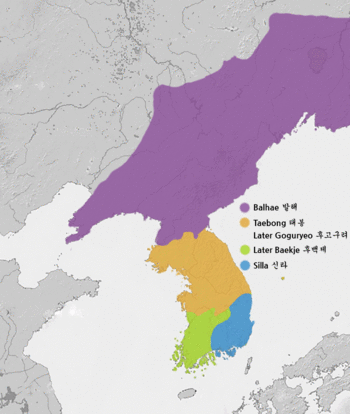تىبونغ
Later Goguryeo 후고구려 (後高句麗) Hugoguryeo 고려 (高麗) Goryeo 마진 (摩震) Majin 태봉 (泰封) Taebong | |||||||||
|---|---|---|---|---|---|---|---|---|---|
| 901–918 | |||||||||
 Taebong at its height in 915. | |||||||||
| العاصمة | Songak (901–905), Cheorwon (905–918) | ||||||||
| اللغات المشتركة | Old Korean, Classical Chinese (literary) | ||||||||
| الدين | Buddhism (state religion), Confucianism, Taoism, Shamanism | ||||||||
| الحكومة | ملكية ثيوقراطية بوذية | ||||||||
| King | |||||||||
• 901–918 | Kung Ye | ||||||||
| التاريخ | |||||||||
• التأسيس | 901 | ||||||||
• Fall | 918 | ||||||||
| |||||||||
| اليوم جزء من | كوريا الجنوبية كوريا الشمالية | ||||||||
| تىبونغ | |
| هانگول | 고려 (901–904) 마진 (904–911) 태봉 (911–918) |
|---|---|
| هانچا | 高麗 (901–904) 摩震 (904–911) 泰封 (911–918) |
| الرومنة المعدلة | Goryeo (901–904) Majin (904–911) Taebong (911–918) |
| مكيون-رايشاور | Koryŏ (901–904) Majin (904–911) T'aebong (911–918) |
|
ما قبل التاريخ
| ||||||
تىبونگ ( Taebong ؛ الكورية: 태봉; هانجا: 泰封; رم: Taebong; م-ر: T'aebong؛ النطق الكوري: [tʰɛ.boŋ]) كانت دولة أسسها Kung Ye (الكورية: 궁예; هانجا: 弓裔) في شبه الجزيرة الكورية في 901 أثناء الممالك الثلاث اللاحقة.[1]
الاسم
The state's initial name was Goryeo، على الاسم الرسمي لـ گوگوريو، الدولة السابقة في منشوريا وشمال شبه الجزيرة الكورية، من القرن الخامس. After suggestion by Ajitae, Kung Ye changed the state's name to Majin(from maha jindan) in 904, and eventually to Taebong in 911. When Wang Kon overthrew Kung Ye and founded the Goryeo dynasty, he restored its original name.
To distinguish Kung Ye's state from Wang Kon's state, later historians call this state Later Goguryeo (Hugoguryeo) or Taebong, its final name.
التاريخ
Taebong was established with the support of the rebellious Silla people, the mixed Goguryeo-Lelang people.
According to legend, Kung Ye was a son of either King Heonan or King Gyeongmun of Silla. A soothsayer prophesied that the newborn baby would bring disaster to Silla, so the king ordered his servants to kill him. However, his nurse hid Kung Ye and raised him secretly.[2] He joined Yang Kil's rebellion force in 892. Silla, after nearly a millennium as a centralized kingdom, was quickly declining, and Kung Ye instigated his own rebellion and absorbed Wang Kon's forces at Songak. In 898, He set up the capital in Songak. He eventually defeated Yang Kil and other local lords in central Korea to proclaim himself king in 901.
Kung Ye transferred the capital from Songak to Cheorwon in 905. Taebong at its peak consisted of territory in the present-day provinces of North and South Hwanghae, Gyeonggi, Gangwon/Kangwon, Pyongyang, North Chungcheong and the southern part of South Jeolla.
In his later days, Kung Ye proclaimed himself a Buddha and became a tyrant who sentenced death to anyone opposing him, including his own wife. Lady Gang. As a result, in 918 four of his own generals—Hong Yu, Pae Hyŏn-gyŏng, Sin Sung-gyŏm and Pok Chigyŏm—overthrew Taebong and installed Wang Kon as King Taejo.[3]
Soon thereafter, Goryeo was established. Taebong influenced Goryeo culturally. Kung Ye was originally a Buddhist monk. He encouraged Buddhism and changed the manners of national ceremonies Buddhist, including the Palgwanhoe (팔관회, 八關會) and Seokdeungnong (석등롱, 石燈籠, Stone lantern). These changes survived the death of Kung Ye and the fall of Taebong.
انظر أيضاً
المراجع
- ^ "Taebong". doopedia.
- ^ 조, 인성 (2007). 태봉의 궁예정권 (Cheopan. ed.). Seoul: Pureun Yeoksa. ISBN 9788991510609.
- ^ 궁예, 디지털한국학 "궁예 - 한국의 명장 - 디지털한국학". Archived from the original on 2008-01-17. Retrieved 2008-01-14.